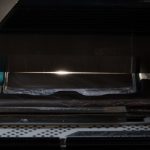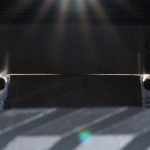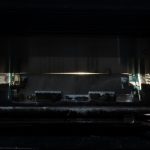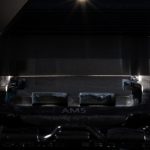Test hardware and systems
The water cooling system used to test the blocks is that of my primary testbench. This basically consists of two circuits, which I can connect together using quick couplings for more water volume and cooling capacity. Loop 1, as I call it, is located directly on my test bench. This consists of a 420 mm Alphacool NexXxoS ST30 radiator and a 240 mm Hardwarelabs Black Ice GTX 240 radiator. The fans are Noiseblocker NB eloops 120 mm fans, 2x from Noiseblocker itself and 4x in the red Phobya version. The water flow is provided by an XSPC D5 Vario pump in an expansion tank attachment from EKWB. Everything is connected with EK-WB ZMT hoses and EK-WB Quantum Torque STC fittings in the 10/16 mm version.
Loop 2 consists of a Watercool MO-RA3 360 PRO with 9 XPG Nidec Vento Pro 120 mm fans. On top of this is the matching Watercool Heatkiller Tube 200 mm reservoir with the second D5 pump, this time from Alphacool in the VPP655T version. For these water block tests, the loops are connected with the Alphacool Eiszapfen quick-release couplings and the pump of Loop 1 is always active. The pump of Loop 2 is switched on for the tests with 2 pumps and disconnected from the power supply for the tests with 1 pump, so it only runs passively. Rough ranges for the flow rate are 135-170 l/h with 2 pumps and 95-120 l/h with 1 pump, depending on the resistance of the respective block. Pumps and fans run statically with 12 V. The flow rate and temperature of the distilled water are recorded by an Aqua Computer high flow NEXT and transmitted to HWinfo via USB. It was reviewed by Igor in the past and verified as one of the few, actually dependable flow / temperature meters. And it’s specifically this component that makes our test also reproducible for basically everyone.
The heat generator in the LGA1700 socket is a Core i9 13900KF, statically overclocked to 5 GHz on the P-cores, 4 GHz on the E-cores and 4.5 GHz cache, with the core voltage set to 1.45 V with LLC5 on the Asus Maximus Z790 Apex motherboard. Under load in Prime95, the voltage drops to 1.19 V, which is actually still far too much for these clock rates – 220 mV too much to be precise. However, there are 2 reasons for this: 1. it generates a higher heat load and thus a higher resolution for our tests and 2. it ensures stable operation of the CPU even with poorer water blocks and consequently higher core temperatures of up to 110 °C. Depending on the temperature, the effective power consumption of the CPU alone is around 300 W here. I cannot use more, as otherwise the CPU will trigger an emergency shutdown (ProcHOT) with poorer water blocks.
In the AM5 socket on the Asus Crosshair X670E Gene is a Ryzen 9 7950X, also statically overclocked to 5 GHz with a voltage setting of 1.375 V and LLC level 5. This drops the voltage here to approx. 1.128 V under load and we generate approx. 280 W of waste heat (approx. 300 W at the EPS connection) and are thus effectively at the temperature limit with less good water blocks.
It is important that the waste heat is as high as possible, as the temperature differences are proportional to it and we can therefore measure larger differences between the blocks. In other words, the resolution of the test is higher. If the CPUs were measured with only 50 W of waste heat, for example, the differences between the blocks would be much smaller. So if another reviewer measures smaller distances between water blocks, it is probably because the CPU is running without OC and with power limit.
At this point it is important to mention that both CPUs are fixed in the socket with their standard mounting frames (ILM). No “washer mods” or aftermarket “frames” are used, as the test is intended to be representative of most users and the water blocks are mainly designed for this purpose. However, the standard ILM, especially with the LGA1700, means that the CPU is effectively bent downwards by the punctual force that the frame applies to the long edges. This effectively creates a dip in the middle of the CPU that has to be overcome by the water block and thermal paste, as this is where the silicon die with the heat-generating cores is located under the integrated heat spreader (IHS). Shortly after the market launch of the LGA1700 socket, we had already reported enough on the topic of “Washermod“.
For this water block test, it means that a block must be at least as convex as the CPU is concave in order to achieve optimum contact. Alternatively, the water block can use a rigid backplate to try to reduce the flexing of the CPU and motherboard, or a combination of both. Interestingly, the AMD CPU is also slightly concave, but not as much. Here again, a less convex cold plate of the water block is optimal. So if a water block is to perform very well on both platforms, it must inevitably make design compromises in order to serve both cases as well as possible. Alternatively, manufacturers can also offer separate blocks for the respective platforms, but this means higher prices and less flexibility for the customer. Who can best manage this balancing act will certainly be a decisive factor in the evaluation of a block!
The thermal paste used is Alphacool Apex, of which I bought a 100g tub. Why this paste? Actually, you could use any other paste as long as all the blocks are measured with the same one. And this is exactly where the subtlety lies. Because I need so much thermal paste for the large number of tests that conventional sizes such as a 10 g tube are far from sufficient. With several tubes, there would be a risk of getting different batches and qualities of paste. The Apex paste was the only one available to me at short notice in such a pack size, so that all blocks could be tested with the same paste and not just the same one. There is even a little left over for possible night tests, e.g. with an aftermarket frame instead of ILM on LGA 1700.
- 1 - Introduction and test methodology
- 2 - Test hardware and systems
- 3 - EK-Quantum Velocity 2 D-RGB 1700
- 4 - Watercool Heatkiller IV Pro
- 5 - Alphacool Core 1 Aurora
- 6 - Aqua Computer cuplex kryos NEXT
- 7 - Thermaltake Pacific SW1 Plus
- 8 - Liquid Extasy No. Uno
- 9 - EK-Quantum Magnitude
- 10 - Corsair Hydro X XC7 RGB Pro
- 11 - Alphacool Eisblock XPX Aurora und XPX Pro 1U
- 12 - Results for Intel LGA 1700 – Core i9 13900KF
- 13 - Results for AMD AM5 – Ryzen 9 7950X
- 14 - Lessons learned, summary and conclusion











































114 Antworten
Kommentar
Lade neue Kommentare
Urgestein
Veteran
Moderator
Urgestein
Veteran
Mitglied
Urgestein
Urgestein
Veteran
Urgestein
Veteran
Veteran
Mitglied
Urgestein
Urgestein
Veteran
Urgestein
Urgestein
Mitglied
Alle Kommentare lesen unter igor´sLAB Community →